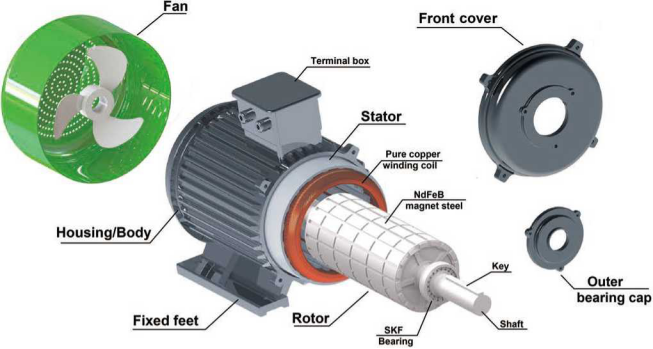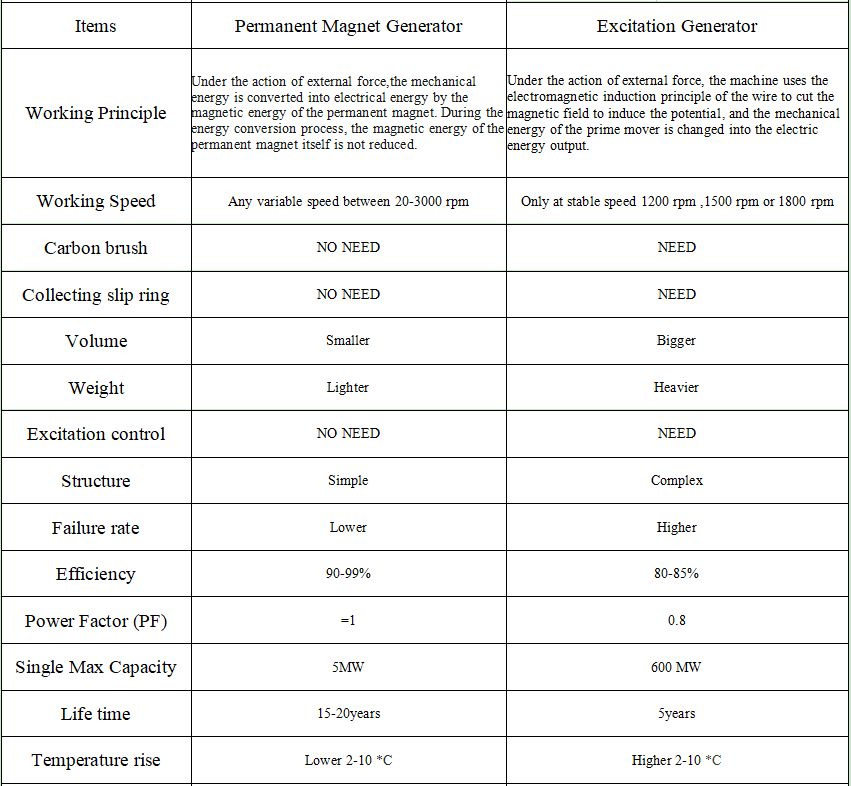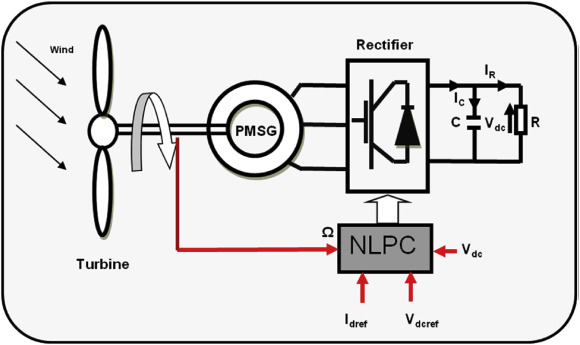Generator sets can be divided into permanent magnet generators and excitation generators. The difference between permanent magnet generators and excitation generators is that their excitation magnetic fields are generated by permanent magnets.
Permanent magnets are both a magnetic source and an integral part of a magnetic circuit in a motor. The excitation power unit provides an excitation current to the rotor of the synchronous generator; while the excitation regulator controls the output permanent magnet generator of the excitation power unit according to the input signal and the given regulation criterion.

The excitation power unit provides an excitation current to the rotor of the synchronous generator; while the excitation regulator controls the output of the excitation power unit according to the input signal and the given regulation criterion.
The automatic excitation regulator of the excitation system plays a considerable role in improving the stability of parallel units in the power system. In particular, the development of modern power systems leads to the trend of reducing the stability limit of units, which also promotes the continuous development of excitation technology. The excitation system of a synchronous generator is mainly composed of two parts: a power unit and a regulator (device).
Among them, the excitation power unit is the excitation power supply part that provides DC excitation current to the rotor winding of the synchronous generator, and the excitation regulator is a device that controls the output of the excitation power unit according to the input signal required by the control and the given adjustment criterion.
The whole system is composed of an excitation regulator, and an excitation power unit and the generator itself is called an excitation system control system. The excitation system is an important part of the generator, which has a great influence on the safe and stable operation of the power system and the generator itself.

The main functions of the excitation system are:
1) Adjust the excitation current according to the change of generator load to maintain the terminal voltage as a given value;
2) Control the reactive power distribution between generators running in parallel;
3) Improve the static stability of the parallel operation of generators;
4) Improve the transient stability of parallel operation of generators;
5) When a fault occurs inside the generator, demagnetization is performed to reduce the degree of fault loss;
6) Implement excitation limitation and small excitation limitation on the generator according to the operation requirements.
1. Excitation mode of DC generator power supply
The generator with this excitation method has a dedicated DC generator, which is called a DC exciter. The exciter is generally coaxial with the generator, and the excitation winding of the generator passes through a slip ring installed on the large shaft. And the fixed brushes get DC current from the exciter.
This excitation method has the advantages of independent excitation current, relatively reliable operation, and reduced self-use electricity consumption. It has been the main excitation method of generators in the past few decades and has relatively mature operating experience. The disadvantage is that the excitation adjustment speed is slow and the maintenance workload is large, so it is rarely used in units above 10MW.
2. Excitation mode of AC exciter power supply
Some modern large-capacity generators use AC exciters to provide excitation current. The AC exciter is also installed on the main shaft of the generator. The AC current output by it is rectified and supplied to the generator rotor for excitation. At this time, the excitation mode of the generator belongs to other excitation modes, and because of the static rectification device, it is also called For separately excited static excitation, the AC auxiliary exciter provides excitation current.
The AC auxiliary exciter can be a permanent magnet machine or an alternator with a self-excited constant voltage device. In order to improve the excitation adjustment speed, the AC exciter usually uses a 100-200HZ intermediate frequency generator, while the AC auxiliary exciter uses a 400-500HZ intermediate frequency generator. The DC excitation winding and three-phase AC winding of this generator are all wound in the stator slot, and the rotor has only teeth and slots but no winding, like a gear, so it has no rotating contact parts such as brushes and slip rings, and has a reliable operation. , simple structure, convenient manufacturing process, and other advantages. The disadvantage is that the noise is large, and the harmonic component of the AC potential is also large.
3. Excitation mode of non-exciter
In the excitation mode, no special exciter is installed, but the excitation power is obtained from the generator itself, and then supplied to the generator itself for excitation after rectification, which is called self-excited static excitation. Self-excited static excitation can be divided into two modes: self-shunt excitation and self-compound excitation.
The self-shunt excitation method obtains the excitation current through the rectifier transformer connected to the generator outlet and supplies the excitation current to the generator after rectification. This excitation method has the advantages of simple structure, less equipment, less investment, and less maintenance work. In addition to the self-resetting excitation method, there is no rectification and transformation, and a high-power current transformer connected in series with the stator circuit of the generator is also provided.
The function of this transformer is to provide a larger excitation current to the generator in case of a short circuit, so as to make up for the insufficient output of the rectifier transformer. This excitation mode has two excitation power sources, the voltage power source obtained through the rectifier transformer and the current source obtained through the series transformer.
Permanent Magnet Generator
1. The difference between a permanent magnet generator and an excitation generator is that its excitation magnetic field is generated by a permanent magnet. Permanent magnets are both a magnetic source and an integral part of a magnetic circuit in a motor.
2. The magnetic performance of a permanent magnet is not only related to the manufacturing process of the manufacturer but also related to the shape and size of the permanent magnet, the capacity of the magnetizer, and the magnetization method. The specific performance data are highly discrete. Moreover, the magnetic flux and magnetomotive force that the permanent magnet can provide in the motor also vary with the material properties, size, and operating status of the rest of the magnetic circuit.
3. In addition, the permanent magnet generator has a variety of magnetic circuit structures. The leakage magnetic circuit is very complex and the leakage flux accounts for a large proportion. The ferromagnetic material part is relatively easy to saturate, and the magnetic permeability is nonlinear. All of these increase the complexity of the electromagnetic calculation of the permanent magnet generator, making the accuracy of the calculation result lower than that of the electric excitation generator.
4. Therefore, a new design concept must be established, and the magnetic circuit structure and control system must be re-analyzed and improved; modern design methods must be applied, and new analysis and calculation methods must be studied to improve the accuracy of design calculations; the testing methods and manufacturing process adopted must be studied.
1. Control issues

After the permanent magnet generator is made, it can maintain its magnetic field without external energy, but it also makes it extremely difficult to adjust and control its magnetic field from the outside. These limit the application range of permanent magnet generators. However, with the rapid development of the control technology of power electronic devices, the permanent magnet generator does not need magnetic field control in the application, but only controls the output of the motor. The design requires the combination of three new technologies of NdFeB material, power electronic devices, and microcomputer control so that the permanent magnet generator can operate under brand-new working conditions.
2. Irreversible demagnetization problem
If the design and use are improper, the permanent magnet generator will be under the action of the armature reaction generated by the impact current when the temperature is too high (NdFeB permanent magnet) or too low (ferrite permanent magnet), or under severe mechanical vibration Sometimes irreversible demagnetization, or demagnetization, may occur, which will reduce the performance of the motor and even make it unusable.
Therefore, it is necessary to research and develop methods and devices for checking the thermal stability of permanent magnet materials suitable for motor manufacturers, and to analyze the anti-demagnetization capabilities of various structural forms, so that corresponding measures can be taken in the design and manufacture of permanent magnets. Generators will not lose their magnetism.
3. Cost issues
Since the current price of rare earth permanent magnet materials is relatively expensive, the cost of rare earth permanent magnet generators is generally higher than that of electric excitation generators, but this cost will be better compensated by the high performance and operation of the motor. In the future design, performance, and price comparisons will be carried out according to specific usage occasions and requirements, and structural innovation and design optimization will be carried out to reduce manufacturing costs.
The difference between the output of the excitation generator and the permanent magnet generator is as follows:

1. Different methods of providing initial electromotive force
When the excitation generator starts, there must be an initial electromotive force for the excitation coil to generate a magnetic field. The electromotive force is provided by the small electromotive force generated by the generator set by an external power supply or a permanent magnet, and it works by its own output voltage after it works normally. The permanent magnet generator set relies on permanent magnets to provide the initial electromotive force.
2. The strength of the magnetic field is different
The excitation generator can change the excitation magnetic field by changing the current of the excitation coil. Moreover, the strength of the magnetic field can be large and controllable. The permanent magnet generator set is prone to magnetic field inclusion phenomenon.